Popular categories
Looking for a yarn?

100% Wool
from 7.00 BGN /50g
The yarn cost is calculated from the pattern’s smallest size and the yarn’s cheapest product type. Looking for an even better price? You might find it on the DROPS Deals!
Little Adventure
Knitted jumper worked top down with round yoke and multi-coloured pattern in DROPS Merino Extra Fine. Size children 3 - 12 years
DROPS design: Pattern no me-024-bn
Yarn group B
----------------------------------------------------------
Size: 3/4 - 5/6 - 7/8 - 9/10 - 11/12 years
Size in cm: 98/104 - 110/116 - 122/128 - 134/140 - 146/152
Materials:
DROPS MERINO EXTRA FINE from Garnstudio
250-250-300-350-350 g colour no 05, light grey
50 g for all sizes of the following colours:
Colour no 01, off white
Colour no 13, denim blue
Colour no 20, dark blue
DROPS DOUBLE POINTED NEEDLES AND CIRCULAR NEEDLE (40 and 60 cm) SIZE 4 mm - or size needed to get 21 sts x 28 rows in stocking st = 10 x 10 cm. NOTE: It is important that the knitting tension is correct vertically to get the right shape on the round yoke.
DROPS DOUBLE POINTED NEEDLES and CIRCULAR NEEDLE (40 and 60 cm) SIZE 3 mm - for rib.
-------------------------------------------------------
Alternative Yarn – See how to change yarns here
Yarn Groups A to F – Use the same pattern and change the yarn here
Yarn usage using an alternative yarn – Use our yarn converter here
-------------------------------------------------------

100% Wool
from 7.00 BGN /50g
The yarn cost is calculated from the pattern’s smallest size and the yarn’s cheapest product type. Looking for an even better price? You might find it on the DROPS Deals!
- English (UK/cm), Bulgaria
- Česky
- Dansk
- Deutsch
- Eesti keel
- English (UK/cm)
- English (US/in)
- Español
- Français
- Íslenska
- Italiano
- Magyar
- Nederlands
- Norsk
- Polski
- Português
- Suomi
- Svenska
- English (UK/cm), Croatia
- English (UK/cm), Greece
- English (UK/cm), Latvia
- English (UK/cm), Lithuania
- English (UK/cm), Romania
- English (UK/cm), Slovenia
- Česky, Slovakia
Pattern instructions
See diagram A.1 - NOTE: Choose diagram for correct size. Work entire pattern in stocking st.
DECREASE TIP (applies to mid under sleeve):
Dec 1 st on each side of marker as follows: Beg 3 sts before marker and K 2 tog, K 2 (marker is between these 2 sts), slip 1 st as if to K, K 1, psso (= 2 sts dec).
----------------------------------------------------------
JUMPER:
Worked in the round on circular needle, top down.
YOKE:
Cast on 84-88-92-100-108 sts on a short circular needle size 3 mm with dark blue. Insert 1 marker at beg of round (= mid back). K 1 round. Then work rib = K 2/P 2 for 3-3-4-4-5 cm (= neck edge). Switch to a short circular needle size 4 mm. K 1 round while at the same time dec 6-4-2-2-3 sts evenly = 78-84-90-98-105 sts. Then work an elevation at the back in stocking st as follows: K 8 sts past marker, turn, tighten yarn and P 16 sts back, turn, tighten yarn and K 24 sts, turn, tighten yarn and P 32 sts back. Continue to work 8 sts more on every turn until a total of 48-48-48-64-64 sts have been worked, turn and K until mid back again. Then continue pattern in the round according to diagram A.1 - NOTE: Choose diagram for correct size (= 13-14-15-14-15 repetitions of 6-6-6-7-7 sts). REMEMBER KNITTING TENSION and switch to a longer circular needle when there are enough sts. When A.1 has been worked, there are 208-224-240-252-270 sts on needle. Work 0-1-2-0-1 cm with light grey. Piece now measures approx. 14-15-16-17-18 cm mid front (measured without rib in the neck). Finish piece in stocking st with light grey. First K 1 round while AT THE SAME TIME inc 4-4-4-12-10 sts evenly = 212-228-244-264-280 sts. Work next round as follows: Work 31-33-35-37-39 sts, slip the next 44-48-52-58-62 sts on 1 stitch holder for sleeve (without working them first), cast on 6 new sts on row, work 62-66-70-74-78 sts (= front piece), slip the next 44-48-52-58-62 sts on 1 stitch holder for sleeve (without working them first), cast on 6 new sts on row and work 31-33-35-37-39 sts.
BODY:
= 136-144-152-160-168 sts. NOW MEASURE PIECE FROM HERE! Continue in the round in stocking st for 23-26-29-32-35 cm. Switch to circular needle size 3 mm. On next round, inc 12-12-12-16-16 sts evenly = 148-156-164-176-184 sts. Then work rib = K 2/P 2 for 3 cm. Then LOOSELY cast off sts with K over K and P over P. Entire jumper now measures approx. 40-44-48-52-56 cm mid front (measured without rib in the neck).
SLEEVE:
Slip sts from one stitch holder on double pointed needles size 4 mm, pick in addition up 1 st in each of the 6 sts cast on in the side of body (insert 1 marker in the middle of these new sts = mid under sleeve) = 50-54-58-64-68 sts on row. NOW MEASURE PIECE FROM HERE! Work in stocking st in the round with light grey. When sleeve measures 2 cm, dec 2 sts mid under sleeve - READ DECREASE TIP. Dec like this every 3-2½-3-2½-2½ cm a total of 7-9-10-13-14 times = 36-36-38-38-40 sts. When sleeve measures 22-26-30-33-37 cm, inc 4-4-6-6-8 sts evenly = 40-40-44-44-48 sts. Switch to double pointed needle size 3 mm and work rib in the round = K 2/P 2 for 3 cm, then LOOSELY cast off with K over K and P over P.
Work the other sleeve the same way.
Diagram

|
= dark blue |

|
= light grey |

|
= off white |

|
= denim blue |

|
= 1 YO between 2 sts in base colour in pattern stripe, on next round K YO twisted to avoid hole |

|
= knitting direction |


What can you do with our patterns? You can share DROPS patterns online, using the pattern original picture, materials, name and number. But you are NOT ALLOWED to reproduce the complete pattern digitally in any way. Yarn stores are welcome to use the DROPS pattern database to promote the sale of our assortment. You can print out our patterns, make as many copies as you’d like. The only thing we ask is that you don't make any changes / additions to the original printed document. And that the patterns according to the DROPS philosophy are given out to the consumers for free. Editorials that wish to publish our patterns in printed books or magazines can contact us for more information. The sale of garments based on DROPS patterns is permitted as long as they are sold as single items or per order. Further commercial use of the patterns is not permitted. It has to be clearly stated that the garment is made based on a design from DROPS DESIGN. The use of clothing labels of which DROPS DESIGN forms part is conditioned by the inclusion of the following text: “A DROPS DESIGN made by …..”. The use of DROPS photos for marketing purposes/sales is only permitted in connection with the use/sale of DROPS products. The photos may not be cut or edited and the logo should be clearly visible.
We reserve the right to withdraw the permission for use of our patterns at any time, notwithstanding the reason.
Each of our patterns has specific tutorial videos to help you.
These step-by-step tutorials might also help you:
Why is the knitting/crochet tension so important?
Knitting tension is what determines the final measurements of your work, and is usually measured per 10 x 10 cm. It is provided like so: number of stitches in width x number of rows in height - eg: 19 stitches x 26 rows = 10 x 10 cm.
The knitting tension is very individual; some people knit/crochet loosely while others work tightly. You adjust the knitting tension with the needle size, which is why the suggested needle size is only meant as a guide! You need to adjust this (up or down) to ensure that YOUR knitting tension matches the knitting tension provided in the pattern. If you work with a different knitting tension than provided you will have a different yarn consumption, and your work will have different measurements than what the pattern suggests.
The knitting tension also determines which yarns can replace each other. As long as you achieve the same knitting tension you can replace one yarn with another.
See DROPS lesson: How to measure your tension/gauge
See DROPS video: How to make a gauge tension swatch
How do I know how many balls of yarn I need?
The required amount of yarn is provided in grams, eg: 450 g. To calculate how many balls you’ll need you first need to know how many grams are in 1 ball (25g, 50g or 100g). This information is available if you click on the individual yarn quality on our pages. Divide the amount required with the amount of each ball. For example, if each ball is 50g (the most common amount), the calculation will be as follows: 450 / 50 = 9 balls.
Can I use a different yarn than what the pattern suggests?
The important thing when changing from one yarn to another is that the knitting/crochet tension remains the same. This is so that the measurements of the finished piece will be the same as on the sketch provided. It is easier to achieve the same knitting tension using yarns from the same yarn group. It is also possible to work with multiple strands of a thinner yarn to achieve the knitting tension of a thicker one. Please try our yarn converter. We recommend you to always work a test swatch.
Please NOTE: when changing yarn the garment might have a different look and feel to the garment in the photo, due to individual properties and qualities of each yarn.
See DROPS lesson: Can I use a different yarn than the one mentioned in the pattern?
What are the yarn groups?
All our yarns are categorised into yarn groups (from A to F) according to thickness and knitting tension – group A contains the thinnest yarns and group F the thickest. This makes it easier for you to find alternative yarns to our patterns, should you wish to switch yarn. All yarns within the same group have a similar knitting tension and can easily replace each other. However, different yarn qualities have different structures and properties which will give the finished work a unique look and feel.
How do I use the yarn calculator?
At the top of all our patterns you’ll find a link to our yarn calculator, which is a helpful tool should you wish to use a different yarn than suggested. By filling in the yarn quality you wish to replace, the amount (in your size) and number of strands, the calculator will present good alternative yarns with the same knitting tension. Additionally it will tell you how much you’ll require in the new qualities and whether you’ll need to work with multiple strands. Most skeins are 50g (some are 25g or 100g).
If the pattern is worked with multiple colours, every colour will have to be calculated separately. Similarly, if the pattern is worked with several strands of different yarns (for example 1 strand Alpaca and 1 strand Kid-Silk) you will have to find alternatives for each, individually.
Why do you show discontinued yarns in the patterns?
Since different yarns have different qualities and textures we have chosen to keep the original yarn in our patterns. However, you can easily find options among our available qualities by using our yarn calculator, or simply pick a yarn from the same yarn group.
It is possible that some retailers still have discontinued yarns in stock, or that someone has a few skeins at home that they would like to find patterns for.
The yarn calculator will provide both alternative yarn as well as required amount in the new quality.
What size should I knit?
If you think it's hard to decide what size to make, it can be a good idea to measure a garment you own already and like the size of. Then you can pick the size by comparing those measures with the ones available in the pattern's size chart.
You'll find the size chart at the bottom of the pattern.
See DROPS lesson: How to read size chart
Why do I get the wrong knitting tension with the suggested needle size?
The needle size provided in the pattern serves only as a guide, the important thing is to follow the knitting tension. And since knitting tension is very individual, you will have to adjust the needle size to ensure that YOUR tension is the same as in the pattern – maybe you’ll have to adjust 1, or even 2 needle sizes, up or down to achieve the correct tension. For this, we recommend that you work test swatches.
Should you work with a different knitting tension than the one provided, the measurements of the finished garment might deviate from the measurement sketch.
See DROPS lesson: How to measure your tension/gauge
See DROPS video: How to make a tension/gauge swatch
Why is the pattern worked top-down?
Working a garment top-down provides more flexibility and room for personal adjustment. For example it is easier to try the garment on while working, as well as making adjustments to length of yoke and shoulder caps.
The instructions are carefully explaining every step, in the correct order. Diagrams are adjusted to the knitting direction and are worked as usual.
How do I work according to a knitting diagram?
The diagram depicts all rows/rounds, and every stitch seen from the right side. It is read from bottom to top, from right to left. 1 square = 1 stitch.
When working back and forth, every other row is worked from the right side and every other row is worked from the wrong side. When working from the wrong side, the diagram will have to be worked reversed: from left to right, knit stitches are purled, purl stitches are knit etc.
When working in the round every round is worked from the right side and the diagram are worked from right to left on all rounds.
See DROPS lesson: How to read knitting diagrams
How do I work according to a crochet diagram?
The diagram depicts all rows/rounds, and every stitch seen from the right side. It is worked from bottom to top, from right to left.
When working back and forth every other row is worked from the right side: from right to left and every other row is worked from the wrong side: from left to right.
When working in the round, every row in the diagram are worked from the right side, from right to left.
When working a circular diagram you start in the middle and work your way outwards, counter clockwise, row by row.
The rows usually start with a given number of chain stitches (equivalent to the height of the following stitch), this will either be depicted in the diagram or explained in the pattern.
See DROPS lesson: How to read crochet diagrams
How do I work several diagrams simultaneously on the same row/round?
Instructions for working several diagrams after each other on the same row/round, will often be written like so: “work A.1, A.2, A.3 a total of 0-0-2-3-4 times". This means you work A.1 once, then A.2 is worked once, and A.3 is repeated (in width) the number of times provided for your size – in this case like so: S = 0 times, M = 0 times, L=2 times, XL= 3 times and XXL = 4 times.
The diagrams are worked as usual: begin with the first row in A.1, then work the first row in A.2 etc.
See DROPS lesson: How to read knitting diagrams
See DROPS lesson: How to read crochet diagrams
Why are the sleeves shorter in larger sizes?
The total width of the garment (from wrist-to-wrist) will be larger in the larger sizes, despite the actual sleeves being shorter. The larger sizes have longer sleeve caps and wider shoulders, so there will be a good fit in all sizes.
Where on the garment is the length measured?
The measurement sketch/schematic drawing provides information regarding the full length of the garment. If it’s a jumper or a jacket the length is measured from the highest point on the shoulder closest to the neckline, and straight down to the bottom of the garment. It is NOT measured from the tip of shoulder. Similarly, the length of yoke is measured from the highest point on the shoulder and down to where yoke is split into body and sleeves.
On a jacket measures are never taken along bands, unless specifically stated. Always measure inside band stitches when measuring the length.
See DROPS lesson: How to read a schematic drawing
What is a repeat?
Diagrams are often repeated on the round or in height. 1 repeat is the diagram the way it appears in the pattern. If it says to work 5 repeats of A.1 in the round, then you work A.1 a total of 5 times after/next to each other in the round. If it says to work 2 repeats of A.1 vertically/in height you work the entire diagram once, then begin again at the start and work the entire diagram one more time.
Why does the piece start with more chain stitches than it’s worked with?
Chain stitches are slightly narrower than other stitches and to avoid working the cast-on edge too tight, we simply chain more stitches to begin with. The stitch count will be adjusted on the following row to fit the pattern and measurement sketch.
Why increase before the rib edge when the piece is worked top-down?
The rib edge is more elastic and will contract slightly compared to, for example, stocking stitch. By increasing before the rib edge, you avoid a visible difference in width between the rib edge and the rest of the body.
Why increase in the cast-off edge?
It’s very easy to cast off too tightly, and by making yarn overs while casting off (and simultaneously casting these off) you avoid a too tight cast off edge.
See DROPS video: How to bind off with yarn overs (yo)
How do I increase/decrease on every 3rd and 4th row/round alternately?
To achieve an even increase (or decrease) you can increase on, for example: every 3rd and 4th row alternately, like so: work 2 rows and increase on the 3rd row, work 3 rows and increase on the 4th. Repeat this until the increase is complete.
See DROPS lesson: Increase or decrease 1 st on every 3rd and 4th row alternately
How can I work a jacket in the round instead of back and forth?
Should you prefer to work in the round instead of back and forth, you may of course adjust the pattern. You’ll need to add steeks mid-front (usually 5 stitches), and follow the instructions. When you would normally turn and work from the wrong side, simply work across the steek and continue in the round. At the end you’ll cut the piece open, pick up stitches to work bands, and cover the cut edges.
See DROPS video: How to knit steeks and cut open
Can I work a jumper back and forth instead of in the round?
Should you prefer to work back and forth instead of in the round, you may of course adjust the pattern so you work the pieces separately and then assemble them at the end. Divide the stitches for the body in 2, add 1 edge stitch in each side (for sewing) and work the front and back pieces separately.
See DROPS lesson: Can I adapt a pattern for circular needles into straight needles?
Why is the pattern slightly different than what I see in the photo?
Pattern repeats can vary slightly in the different sizes, in order to get the correct proportions. If you’re not working the exact same size as the garment in the photo, yours might deviate slightly. This has been carefully developed and adjusted so that the complete impression of the garment is the same in all sizes.
Make sure to follow instructions and diagrams for your size!
How do I make a women’s size garment into a men’s size one?
If you have found a pattern you like which is available in women’s size it’s not very difficult to convert it to men’s size. The biggest difference will be the length of sleeves and body. Start working on the women size that you think would fit across the chest. The additional length will be worked right before you cast off for the armhole/sleeve cap. If the pattern is worked top-down you can add the length right after the armhole or before the first decrease on sleeve.
Regarding additional yarn amount, this will depend on how much length you add, but it is better with a skein too many than too few.
How do I prevent a hairy garment from shedding?
All yarns will have excess fibres (from production) that might come off as lint or shedding. Brushed yarns (ie hairier yarns) have more of these loose, excess fibres, causing more shedding.
Shedding also depends on what is worn under or over the garment, and whether this pulls at the yarn fibres. It’s therefore not possible to guarantee that there will be no shedding
Below are some tips on how to get the best result when working with hairier yarns:
1. When the garment is finished (before you wash it) shake it vigorously so the looser hairs come off. NOTE: do NOT use a lint roller, brush or any method that pulls at the yarn.
2. Place the garment in a plastic bag and put it in your freezer - the temperature will cause the fibres to become less attached to each other, and excess fibres will come off easier.
3. Leave in the freezer for a few hours before taking it out and shaking it again.
4. Wash the garment according to the instructions on the yarn label.
Why does my garment pill?
Pilling is a natural process that happens to even the most exclusive of fibers. It's a natural sign of wear and tear that is hard to avoid, and that is most visible in high friction areas of your garment like a sweater's arms and cuffs.
You can make your garment look as new by removing the pilling, using a fabric comb or a pill/lint remover.
In the meantime, you can read the questions and answers that others have left to this pattern or join the DROPS Workshop on Facebook to get help from fellow knitters/crocheters!
You might also like...
Little Adventure
Little Adventure
Little Adventure
I Gemelli diversi
Little Adventure |
|||||||||||||||||||
 |
 |
||||||||||||||||||
Knitted jumper worked top down with round yoke and multi-coloured pattern in DROPS Merino Extra Fine. Size children 3 - 12 years
DROPS Children 27-32 |
|||||||||||||||||||
|
PATTERN: See diagram A.1 - NOTE: Choose diagram for correct size. Work entire pattern in stocking st. DECREASE TIP (applies to mid under sleeve): Dec 1 st on each side of marker as follows: Beg 3 sts before marker and K 2 tog, K 2 (marker is between these 2 sts), slip 1 st as if to K, K 1, psso (= 2 sts dec). ---------------------------------------------------------- JUMPER: Worked in the round on circular needle, top down. YOKE: Cast on 84-88-92-100-108 sts on a short circular needle size 3 mm with dark blue. Insert 1 marker at beg of round (= mid back). K 1 round. Then work rib = K 2/P 2 for 3-3-4-4-5 cm (= neck edge). Switch to a short circular needle size 4 mm. K 1 round while at the same time dec 6-4-2-2-3 sts evenly = 78-84-90-98-105 sts. Then work an elevation at the back in stocking st as follows: K 8 sts past marker, turn, tighten yarn and P 16 sts back, turn, tighten yarn and K 24 sts, turn, tighten yarn and P 32 sts back. Continue to work 8 sts more on every turn until a total of 48-48-48-64-64 sts have been worked, turn and K until mid back again. Then continue pattern in the round according to diagram A.1 - NOTE: Choose diagram for correct size (= 13-14-15-14-15 repetitions of 6-6-6-7-7 sts). REMEMBER KNITTING TENSION and switch to a longer circular needle when there are enough sts. When A.1 has been worked, there are 208-224-240-252-270 sts on needle. Work 0-1-2-0-1 cm with light grey. Piece now measures approx. 14-15-16-17-18 cm mid front (measured without rib in the neck). Finish piece in stocking st with light grey. First K 1 round while AT THE SAME TIME inc 4-4-4-12-10 sts evenly = 212-228-244-264-280 sts. Work next round as follows: Work 31-33-35-37-39 sts, slip the next 44-48-52-58-62 sts on 1 stitch holder for sleeve (without working them first), cast on 6 new sts on row, work 62-66-70-74-78 sts (= front piece), slip the next 44-48-52-58-62 sts on 1 stitch holder for sleeve (without working them first), cast on 6 new sts on row and work 31-33-35-37-39 sts. BODY: = 136-144-152-160-168 sts. NOW MEASURE PIECE FROM HERE! Continue in the round in stocking st for 23-26-29-32-35 cm. Switch to circular needle size 3 mm. On next round, inc 12-12-12-16-16 sts evenly = 148-156-164-176-184 sts. Then work rib = K 2/P 2 for 3 cm. Then LOOSELY cast off sts with K over K and P over P. Entire jumper now measures approx. 40-44-48-52-56 cm mid front (measured without rib in the neck). SLEEVE: Slip sts from one stitch holder on double pointed needles size 4 mm, pick in addition up 1 st in each of the 6 sts cast on in the side of body (insert 1 marker in the middle of these new sts = mid under sleeve) = 50-54-58-64-68 sts on row. NOW MEASURE PIECE FROM HERE! Work in stocking st in the round with light grey. When sleeve measures 2 cm, dec 2 sts mid under sleeve - READ DECREASE TIP. Dec like this every 3-2½-3-2½-2½ cm a total of 7-9-10-13-14 times = 36-36-38-38-40 sts. When sleeve measures 22-26-30-33-37 cm, inc 4-4-6-6-8 sts evenly = 40-40-44-44-48 sts. Switch to double pointed needle size 3 mm and work rib in the round = K 2/P 2 for 3 cm, then LOOSELY cast off with K over K and P over P. Work the other sleeve the same way. |
|||||||||||||||||||
Diagram explanations |
|||||||||||||||||||
|
|||||||||||||||||||

|
|||||||||||||||||||

|
|||||||||||||||||||
|
Have you made this or any other of our designs? Tag your pictures in social media with #dropsdesign so we can see them! Do you need help with this pattern?You'll find tutorial videos, a Comments/Questions area and more by visiting the pattern on garnstudio.com. © 1982-2024 DROPS Design A/S. We reserve all rights. This document, including all its sub-sections, has copyrights. Read more about what you can do with our patterns at the bottom of each pattern on our site. |
|||||||||||||||||||
With over 40 years in knitting and crochet design, DROPS Design offers one of the most extensive collections of free patterns on the internet - translated to 17 languages. As of today we count 304 catalogues and 11422 patterns - 11422 of which are translated into English (UK/cm).
We work hard to bring you the best knitting and crochet have to offer, inspiration and advice as well as great quality yarns at incredible prices! Would you like to use our patterns for other than personal use? You can read what you are allowed to do in the Copyright text at the bottom of all our patterns. Happy crafting!







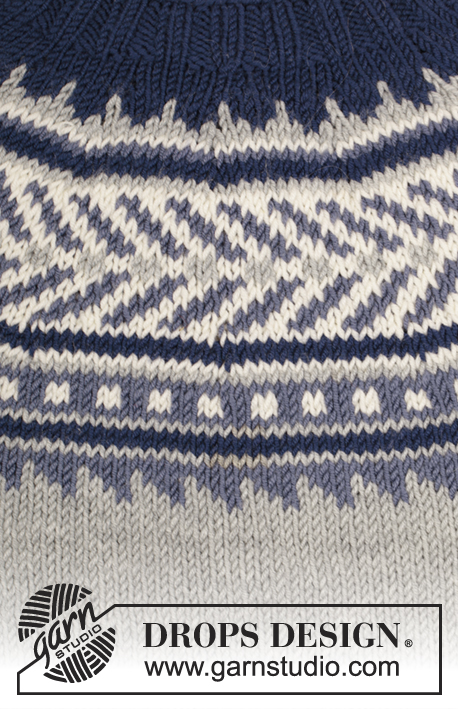

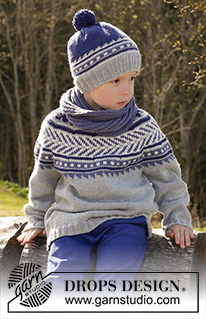














































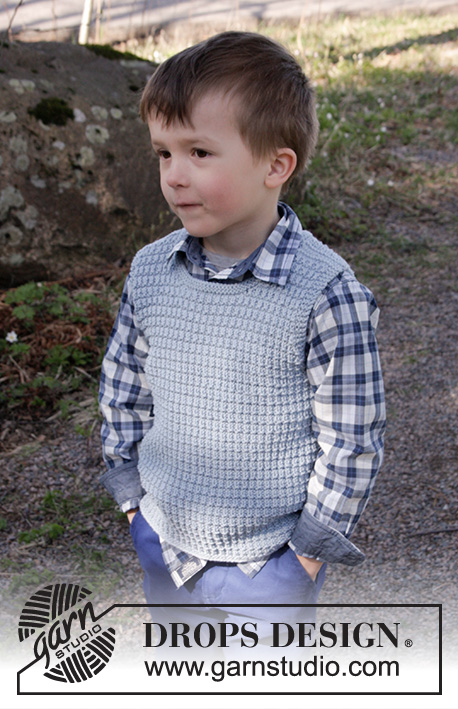
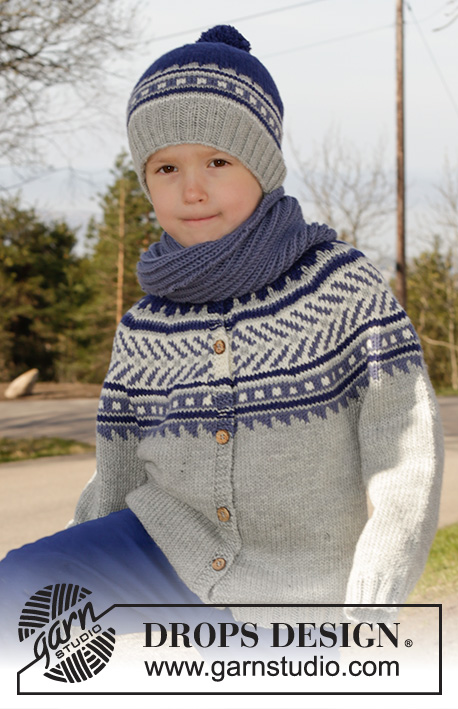
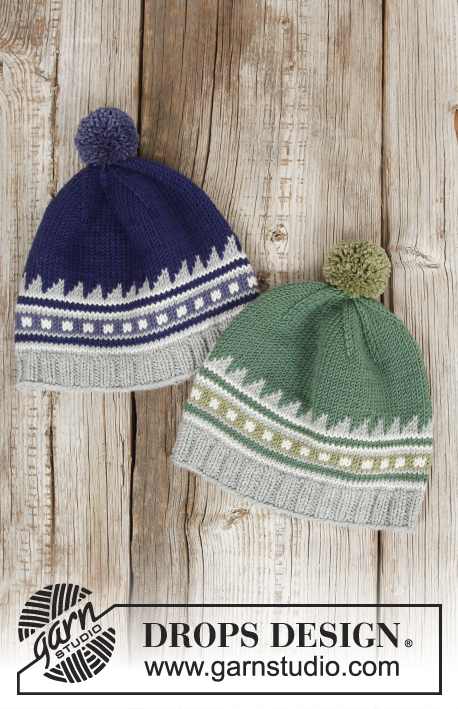



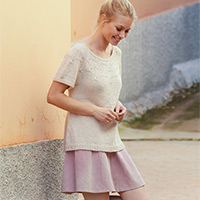
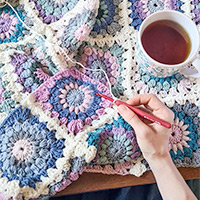
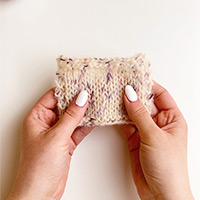
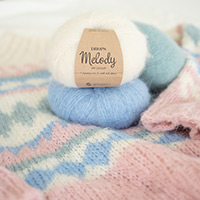
Comments / Questions (18)
Hei, Ut ifra tegningen ser det ut som genseren skal være 40 cm lang total? Vet jo at det kan jeg tilpasse som jeg vil, men etter å ha regnet på vrangbord pluss mønsterdiagram pluss bol ( 3cm + 14cm + 23cm)kommer jeg frem til 40 cm før vrangbord? Altså total lengde etter diagrammet på 43 cm?
14.10.2018 - 20:06DROPS Design answered:
Hei Ann Kristin. Genseren er 40 cm lang opp til de 3 cm på skulderen, så det stemmer det du har regnet ut: at den er 43 cm lang totalt. God fornøyelse.
22.10.2018 - 11:23Bonjour, Je suis une novice en tricot nordique et j'ai du mal à comprendre ce passage "Tricoter ensuite une ré-hausse pour l'encolure dos ainsi en jersey: tricoter 8 m end après le marqueur, tourner, serrer le fil et tricoter 16 m env au rang retour..." La notion de réh-hausse , tourner et passer le fil ? avez vous une vidéo . Merci
15.01.2018 - 19:24DROPS Design answered:
Bonjour Mme Edhen, cette vidéo montre comment tricoter la ré-hausse du milieu dos - suivez bien le nombre de mailles de votre modèle, et pas celui de la vidéo. Bon tricot!
16.01.2018 - 09:09Wird der Rapport von links nach rechts oder umgekehrt gelesen? Wenn ich zu Beginn einer neuen Reihe und Farbe einen Umschlag machen muss, wie funktioniert dann der Tipp die Treppen beim Streifenstricken zu vermeiden?
29.12.2017 - 09:06DROPS Design answered:
Liebe Frau Witt, die Diagramme werden von rechts nach links jeder Runde gestrickt. Sie können den Umschlag mit den selben Farben der Runde stricken, dann bei der nächster Runde Faden etwas festziehen, damit keine Treppe entstehen. Gerne wird Ihnen Ihr DROPS Laden noch mehr Tipp geben. Viel Spaß beim stricken!
02.01.2018 - 10:00Eine Frage zu den Bündchen. In der Anleitung steht, dass vor Beginn der Bündchen, Maschen zugenommen werden müssen. Das ist doch sicherlich falsch. Sie müssen bestimmt abgenommen werden. Was meinen Sie?
29.11.2017 - 15:44DROPS Design answered:
Liebe Monika, es muß zugenommen und nicht abgenommen: um zu vermeiden, daß die Bündchen das Stück in der Breite verkleinern, wird es zugenommen. Viel Spaß beim stricken!
29.11.2017 - 16:09Strikker en del, men sjelden ovenfra og ned. synest det er mange masker til hals og at det skal økes ut for vrangbord nede. Blir denne vid i halsen, ønsker hals som model 23/16. i halsen? Har kikka litt rundt på fleire modeller, men ser ut som alle skal økes ut for vrangbord nede, blir ikkje den veldig vid da?
28.09.2017 - 13:33DROPS Design answered:
Hei Åshild. Om du ser på målskissene (helt nederst) til både children 23-16 og 27-32, vil du se at 27-32 har et mindre mål enn 23-16 i halsen. Ettersom denne modellen strikkes ovenfra og ned, er det mulighet til å prøve genseren på selv om man bare er kommet halvveis. Nesten alle nye modeller økes det i vrangborden (nederst), slik at plagget feller penere. Selv om det økes, trekkes det sammen når det strikkes vrangbord. Skulle du ønske å felle av istedenfor, kan du fint gjøre det. God Fornøyelse!
28.09.2017 - 14:03Hallo, ich würde sehr gern für meinen Enkel den Pullover nachstricken, Wo finde ich das Musterdiagramm? Danke Martina
20.04.2017 - 10:38DROPS Design answered:
Liebe Frau Wechselberger, Diagram kann man jetzt wieder sehen, das können Sie jetzt drücken. Viel Spaß beim stricken!
20.04.2017 - 11:44Hvordan øker man i bærestykket? Øker man i hver omgang? Hvor mange masker øker man med? Er ganske 'fersk' på strikking og er ikke så god til å lese oppskrifter enda:)
16.03.2017 - 20:56DROPS Design answered:
Hej Ida. Der ökes automatisk i og med du strikker diagrammerne (se nederst), du öker med et kast og i naeste omgang strikker du strikkes kastet vridd rett slik at det ikke blir hull
20.03.2017 - 13:05Buenas, me está quedando el jersey muy bien pero he llegado al final de la pechera y me surge una duda. En la explicación del patrón pone " Tejer 31-33-35-37-39 pts, deslizar los 44-48-52-58-62 pts siguientes en 1 gancho auxiliar para la manga (sin tejerlos primero), montar 6 nuevos pts en la hilera...." y no entiendo lo de montar 6 nuevos puntos en la hilera. Hay algún video que lo explique???? Gracias por la rápida respuesta
20.09.2016 - 19:46DROPS Design answered:
Hola Isabel. Este video te puede ayudar:
23.09.2016 - 19:53